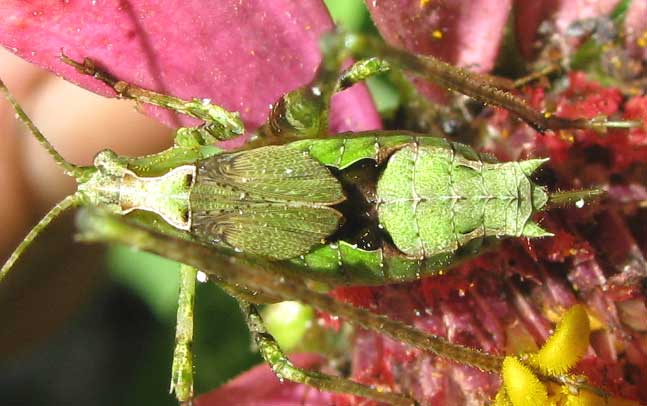Excerpts from Jim Conrad's
Naturalist Newsletter

from the August 1, 2010 Newsletter issued from Hacienda Chichen Resort beside Chichén Itzá Ruins, central Yucatán, MÉXICO; limestone bedrock, elevation ~39m (~128ft), ~N20.676°, ~W88.569°
FOUR BUGS IN ONE
While admiring the zinnias planted before my hut I saw something that at first glance struck me as a green flower- or crab-spider, one of those small, big-headed ones with a flat face and crabby legs often seen in flower centers waiting to pounce on prey. However, something didn't seem right so as my mind struggled to make more sense of things suddenly I saw that the "flower spider" was facing the rear end of a much larger, green bug with two short, hornlike antennae.
And then yet a third insect became apparent, this one in which the "green bug's" spiky antennae actually were open jaws, with dark-green compound eyes just behind the jaws, an insect something like a green antlion. Finally I realized that "flower spider," "green bug" and "antlion" were all just camouflage patterns on a larger insect, the one shown at the top of this page.
Can you see all four critters? It might help to defocus your eyes and view it from a distance. The "real" insect faces toward the left, its antennae extending beyond the picture's left side. Its pale head and thorax form the backward-looking, hourglass-shaped "flower spider" (note the dark compound eyes). The "green bug's" two antenna or the "antlion's" open mandibles are spiny projections on the real insect's rear end. You can see the real insect from the side below:

That looks like a late-instar nymphal stage of an angular-winged katydid, but here we have so many katydid species that I'm not even bothering Bea in Ontario to see if she can identify it to species level.
Of course the fake spider design might deter a katydid-eating predator, and that same predator might attack the katydid's rear end, regarding it as the head of a green bug or an antlion-thingy, thus sparing the katydid's real head at the other end, which is more important.
*UPDATE: In 2024, with many more resources on the Internet, I upload this page's pictures to iNaturalist, where user "typophylllum" recognized the genus Insara. Searching for Insara species in Mexico, INSARA PHTHISICA was found with features appearing to match our pictures. Also, in the 1914 study by James Rehn and Morgan Hebard "A Revision of the Orthopterous Group Insarae (Tettigoniidae, Phaneropterinae)," it's seen that the type specimen -- the individual described when introducing Insara phthisica to science -- was collected in Temax, about 50kms north of our location.